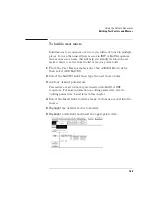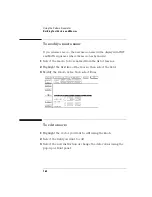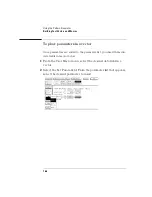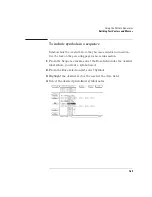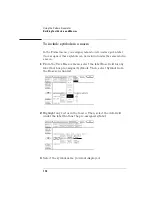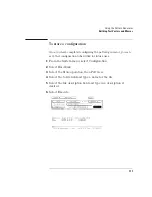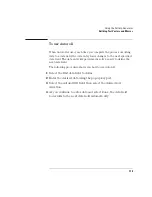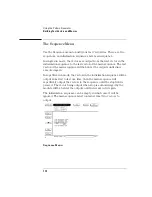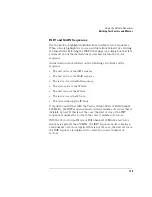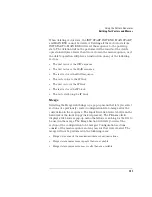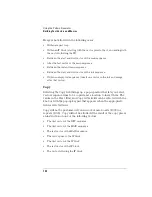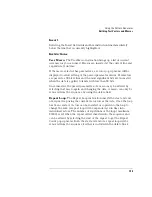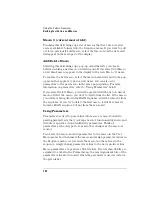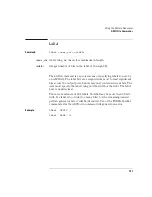
176
Using the Pattern Generator
Building Test Vectors and Macros
Clock Out Delay
The Clock Out Delay setting allows you to position the output clock
with respect to data. The zero setting is uncalibrated and should be
measured to determine the initial position with respect to the data.
Each numerical change of one on the counter results in an approximate
change of 1.3 ns.
Symbols
Touching the Symbols field brings up a pop-up menu that lets you build
a symbol table to use when putting data into the Sequence and User
Macros menus. Providing symbol names to frequently used values lets
you enter the values more easily and recognize these values by their
symbol name rather than having to remember data values.
Vector Output Mode
The Vector Output Mode determines the channel width, available pods,
and the frequency range for both the internal and external clock. The
following table shows the difference between the Full Channel 100
MBits/s mode and the Half Channel 200 MBits/s mode.
Full Channel
100 MBits/s
Half Channel
200 MBits/s
Pods Available
Pods 1, 2, 3, 4
Pods 1, 3
Maximum Channels
32; eight per
pod
16; eight on pods
1, 3
Maximum External Clock
Frequency
100 MHz
200 MHz
Maximum Internal Clock
Frequency
100 MHz
200 MHz
Minimum External Clock
Frequency
DC
DC
Minimum Internal Clock
Frequency
4 kHz
4 kHz
Summary of Contents for 1670E Series
Page 6: ...6 In This Book...
Page 26: ...26 Contents...
Page 27: ...27 Section 1 Logic Analyzer...
Page 28: ...28...
Page 29: ...29 1 Logic Analyzer Overview...
Page 39: ...39 2 Connecting Peripherals...
Page 49: ...49 3 Using the Logic Analyzer...
Page 72: ...72 Using the Logic Analyzer The Inverse Assembler...
Page 73: ...73 4 Using the Trigger Menu...
Page 101: ...101 5 Using the Oscilloscope...
Page 151: ...151 6 Using the Pattern Generator...
Page 199: ...199 7 Triggering Examples...
Page 237: ...237 8 File Management...
Page 249: ...249 9 Logic Analyzer Reference...
Page 360: ...360 Logic Analyzer Reference The Compare Menu...
Page 361: ...361 10 System Performance Analysis SPA Software...
Page 397: ...397 11 Logic Analyzer Concepts...
Page 430: ...430 Logic Analyzer Concepts The Analyzer Hardware Oscilloscope board theory Oscilloscope board...
Page 439: ...439 12 Troubleshooting the Logic Analyzer...
Page 455: ...455 13 Specifications...
Page 471: ...471 14 Operator s Service...
Page 479: ...479 Operator s Service Troubleshooting Troubleshooting Flowchart 2...
Page 491: ...491 Section 2 LAN...
Page 492: ...492...
Page 493: ...493 15 Introducing the LAN Interface...
Page 497: ...497 16 Connecting and Configuring the LAN...
Page 506: ...506 Connecting and Configuring the LAN Connecting and Configuring the LAN...
Page 507: ...507 17 Accessing the Logic Analyzer File System Using the LAN...
Page 515: ...515 18 Using the LAN s X Window Interface...
Page 527: ...527 19 Retrieving and Restoring Data Using the LAN...
Page 539: ...539 20 Programming the Logic Analyzer Using the LAN...
Page 546: ...546 Programming the Logic Analyzer Using the LAN Programming the Logic Analyzer Using the LAN...
Page 547: ...547 21 LAN Concepts...
Page 555: ...555 22 Troubleshooting the LAN Connection...
Page 580: ...580 Troubleshooting the LAN Connection Getting Service Support...
Page 581: ...581 Section 3 Symbol Utility...
Page 582: ...582...
Page 583: ...583 23 Symbol Utility Introduction...
Page 588: ...588 Symbol Utility Introduction Symbol Utility Introduction...
Page 589: ...589 24 Getting Started with the Symbol Utility...
Page 597: ...597 25 Using the Symbol Utility...
Page 609: ...609 26 Symbol Utility Features and Functions...


